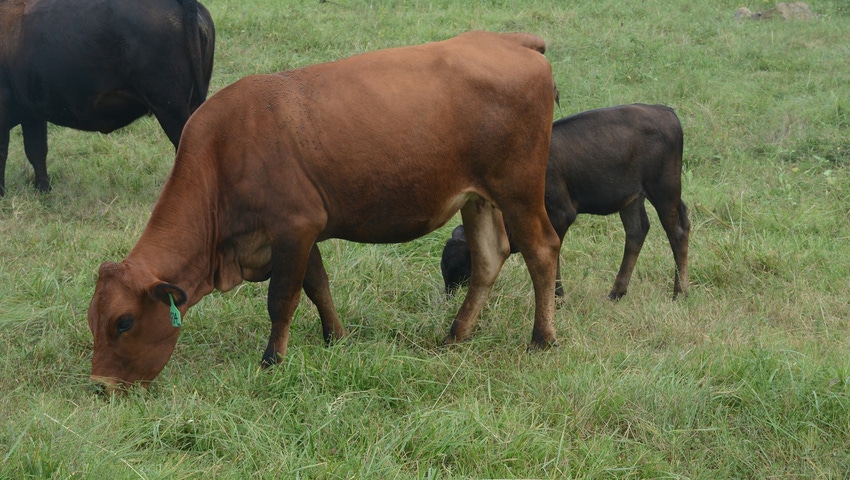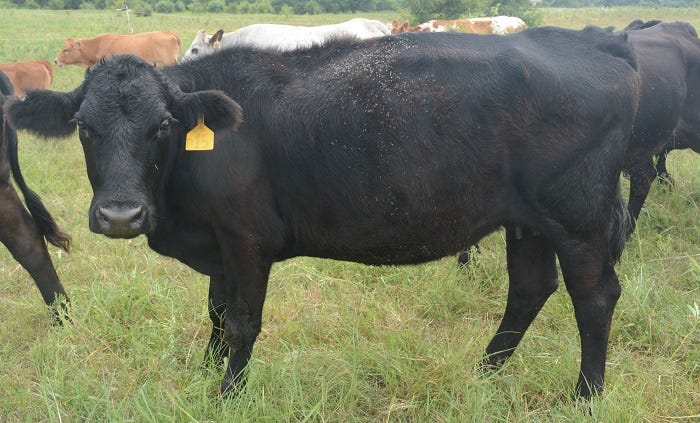
In my last blog, I wrote about some of the issues with forage management in ultra-high-stock-density, non-selective grazing. Now I’m continuing with descriptions of the livestock issues.
Livestock is really the heart of the matter, and the part of the equation where most difficulties arise. The grazing is really just a matter of commitment and practice. But trying to get today’s cattle to perform under these circumstances is the struggle. For the 30 years or so I’ve been involved in grazing management, people have talked about needing to change their cattle type to fit their new management techniques. It’s even more difficult as you demand higher consumption.
The lower end of ultra-high-density-grazing (UHDG) is generally considered to be 200,000 pounds of stock to the acre, or a little more. Most of the time, I’m working at 200,000 to 350,000 pounds stock density. I have worked with cattle at up to 1 million pounds stock density.
This is a side note to the cattle performance, but it’s important information. When I visited the late Neil Dennis in Canada more than 10 years ago, he was getting almost total consumption and/or trampling of plants in UHDG paddocks. I cannot achieve that in southern Plains native pasture, regardless how high my stock density goes. There are too many woody plants. These may be grazed hard or not, depending on time of year and palatability, but they are rarely laid flat. Just a fact to be aware of for those who try UHDG.
As I mentioned in my previous blog, non-selective grazing has much higher consumption and trampling than grazing at lower stock density. It does a much better job of creating a competitive habitat for all plant species, and better yet, for grazeable species. But it is much more like haying. By that I mean it feeds the cattle an average of much lower-quality, less-digestible plant material. If you’ve ever studied hay quality and/or research on grab samples versus fistulated cattle forage quality, you’ll understand what I mean.
These same demands and problems occur to a lesser degree with selective grazing and various types of rotational grazing, but UHDG with non-selective grazing takes this to a new level. And as I wrote in the last blog, the modern cattle type is the least suited to consuming and thriving on low-quality forage. They have been selected for grain consumption, large size, heavy milk production, and the inability to lay on fat. This has been done though feed-efficiency bull-driven genetics, inserted into nearly all the nation’s cow herds either directly or secondarily.
Cow type
Typically, research shows smaller cows are more efficient (and even can be more profitable in the feedlot), but my own experience shows these smaller cows are highly variable. I have some good ones and some really bad ones. Here’s a short summary of what I did and what I’ve found. I bought mostly sale-barn cattle, starting with 700-750 pound pregnant heifers in the winter of 2018. This was back-figured along with calving date to generally assume they were pregnant by 500 pounds, therefore mostly being 1,000-pound cows. Generally, that worked, but I would not do that again for a lot of reasons. I would go with small-framed mature cows. I would also avoid black genetics entirely because the percentage of heat-intolerance is much higher in black-coated cattle than in lighter-colored cattle.
At any rate, some of these cows do pretty well while dry and then fall completely apart with a calf (Too much milk). Some do pretty well when dry and then get by while nursing a calf. Some are just poor doers. Some have very high heat intolerance and do poorly even with shade, I believe because they spend too much time panting and too little time eating.
A little handful thrive and raise good calves. The two best cows I have are Mashona-Aubrac crosses. One is a first-calf heifer. The other is raising her second calf. All are beautiful. The next-best cow was a huge surprise to me because based on my expectations she is a little too tall and a little too leggy, but she stays in good flesh and her calf is growthy and healthy. All three of these are hormonally balanced and slick off their winter coats relatively early and stay shiny nearly all year, and seem to rebreed easily. I can put more pressure on them or less, from the standpoint of non-selective versus selective grazing, and they seem always to thrive as long as I’m giving them enough forage.
I also have an adult bull that is about frame 4 and stays in great flesh no matter what. He is muscular and masculine and descends from a great Mashona bull and some old Lasater-Casey foundation Beefmaster stock. And I own a young bull that is full brother to the Mashona-Aubrac first-calf heifer I mentioned. He keeps easily and has gained rapidly. I like his low-input parents and he shows masculinity and promise.
A protein lick helps cattle in these conditions. Protein supplement in the form of cake or alfalfa helps them even more. But too much help costs a lot of money and I’m aiming for low-input cattle that can crank out a lot of pounds of beef per acre and not break the bank doing it. Finding a balance is one of my struggles.
My short-term solution is to ease up a little on the non-selective grazing, leaving a little more ungrazed or partially grazed forage behind. I’m allowing a little more selectivity to increase performance. I’m also regrazing some of the forage while it is in stage two growth, also thereby increasing quality of the diet. Incidentally, this is all with green-grass calving, starting in early May.

Goal is profit
My goal, which I may not have clearly stated, is to increase my stocking rate many times over, build the soil and forage in quality and quantity, and have cows that perform well, rebreed on time, and produce a fast-growing and early maturing calf. This produces high profitability.
If I feed the poor cows (along with all the others) too much in these early years, I will cost myself a lot of money and make it harder to pick the good ones. On the other hand, if I am really hard on them and I sell the thin cows at the end of calving season I’ll take a financial beating. It makes more sense to me to use Doug-Ferguson/Wally-Olson marketing and put some weight on them, get them bred and sell in the late winter or spring at a higher price. I have plenty of forage and the main cost is winter protein supplement.
Further, I can’t just sell the mediocre ones and buy better. Not in this country. I’ve been to plenty of sales and seen very few cows I would take a chance on. A few buyers might be able to pick me up a load of this type pregnant cows, but then I may put off uprading my genetics even longer. It takes constant analyzing, re-analyzing and market watching.
As I said, it isn’t possible to just buy what I need. I can spend a lot of money trying to buy the kind of cattle I want and need, and still get a bunch of junk. The right bull is the answer. I am convinced you have to breed your way into this type of cows. Read “Selection made simple: Pick the 8-in-5 package” for more on this thinking.
That’s the genetic side of UHDG and non-selective grazing. I’ll write one more blog on how to vary grazing and forage age to match nutritional needs of the cows. I’ve done a much better job this summer than last. Watch for that in my next blog.
About the Author(s)
You May Also Like




